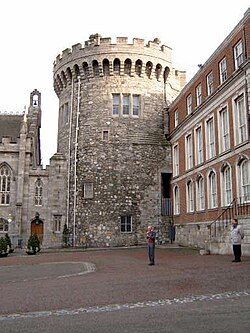Dublin Castle: Difference between revisions
Also needs material on River Poddle, Dubh Linn, new garden. Ended "St. Patrick's Hall" link, led to Uni of Reading. |
m Correcting Chester Beatty, and linking. |
||
| Line 21: | Line 21: | ||
The last dignitary to stay in the royal bedrooms was [[Margaret Thatcher]], who spent the night there with her husband Dennis during the 1979 [[European Council]] meeting. |
The last dignitary to stay in the royal bedrooms was [[Margaret Thatcher]], who spent the night there with her husband Dennis during the 1979 [[European Council]] meeting. |
||
Dublin Castle is currently maintained by the [[Office of Public Works]], and houses, among other things, |
Dublin Castle is currently maintained by the [[Office of Public Works]], and houses, among other things, offices of the [[Revenue Commissioners]], in a twentieth century building at the end of the Castle Yard, some elements of the Office of Public Works itself, in an old stables area, and some functions of the [[Garda Siochana]]. |
||
The castle complex also hosts the Chester Beatty |
The castle complex also hosts the [[Chester Beatty Library]], in a purpose-constructed facility. |
||
== See also == |
== See also == |
||
Revision as of 07:15, 17 May 2007
On the left is the state entrance and the Viceregal Apartments. The Irish Crown Jewels were stolen from the building to the right.
Dublin Castle in Dublin, Republic of Ireland, is a major fortified complex, and was the seat of British rule in Ireland until 1922. Most of the complex dates from eighteenth century, though a castle has stood on the site since the days of King John, the first Lord of Ireland and the Castle served as the seat of British government of Ireland under the Lordship of Ireland (1171-1541), Kingdom of Ireland (1541-1800) and United Kingdom of Great Britain and Ireland (1800-1922).
Dublin Castle fulfilled a number of roles over the centuries. It was first and foremost a royal residence, resided in by the Lord Lieutenant of Ireland or Viceroy of Ireland, the representative of the monarch. The Viceregal Apartments (now called the State Apartments) remain one of the most splendid sites in Dublin, and are the location of the inauguration of the President of Ireland. The second in command in the Dublin Castle administration, the Chief Secretary for Ireland, also had his offices there. Over the years, parliament and the law courts met there, before moving to new purpose-built venues. It also served as a military garrison.
with the throne of the Viceroy and Vicereine on the dais. Circa 1900.
Throughout the British rule of Ireland, "Castle Catholic" was a pejorative term for Catholics who were seen to be overly friendly with or supportive of the British administration.
Famously, the Irish Crown Jewels were stolen from the Castle in 1907.

During the Anglo-Irish War the Castle was the nerve centre of the British effort against Irish separatism. On the night of Bloody Sunday in 1920, two Irish Republican Army officers and a friend were killed, "while trying to escape", in the grounds of the Castle.
Pre-World War One photograph
The Castle ceased to be used for government purposes when the Irish Free State came into being in 1922. It served for some years as temporary Courts of Justice (the Four Courts, the home of the Irish courts system had been destroyed in 1922.) Once the courts moved out, Dublin Castle was used for state ceremonial. Éamon de Valera as President of the Executive Council on behalf of King George V received credentials from ambassadors to Ireland there in the 1930s. In 1938 it was used for the inauguration of Douglas Hyde as President of Ireland. Inaugurations of subsequent presidents took place there in 1945, 1952, 1959, 1966, 1973, 1974, 1976, 1983, 1990 and 1997. President Erskine Hamilton Childers' lying-in-state took place there in November 1974, as did that of former President Eamon de Valera, in September, 1975.

To its left is the Chapel Royal.
The castle is a tourist attraction and, following major refurbishment, is also used as a conference centre. During Ireland's presidencies of the European Union, including most recently in the first half of 2004, it has been the venue of many meetings of the European Council. The crypt of the Chapel Royal is now used as an arts centre, and occasional concerts are held in the grounds of the Castle.
The complex of buildings is usually open to the public, except during state functions. Among the areas open for viewing are St. Patrick's Hall, a vast ballroom in which state presidential inaugurations take place, the Throne Room, containing a throne from the reign of King William III, and the Viceregal Apartments, which include the rooms once used by the Lords Lieutenant and visiting members of the Royal Family.
The last dignitary to stay in the royal bedrooms was Margaret Thatcher, who spent the night there with her husband Dennis during the 1979 European Council meeting.
Dublin Castle is currently maintained by the Office of Public Works, and houses, among other things, offices of the Revenue Commissioners, in a twentieth century building at the end of the Castle Yard, some elements of the Office of Public Works itself, in an old stables area, and some functions of the Garda Siochana.
The castle complex also hosts the Chester Beatty Library, in a purpose-constructed facility.
See also
External links
53°20′35″N 6°16′04″W / 53.342926°N 6.267802°W
Dublin Castle is in Ireland.

